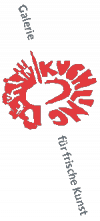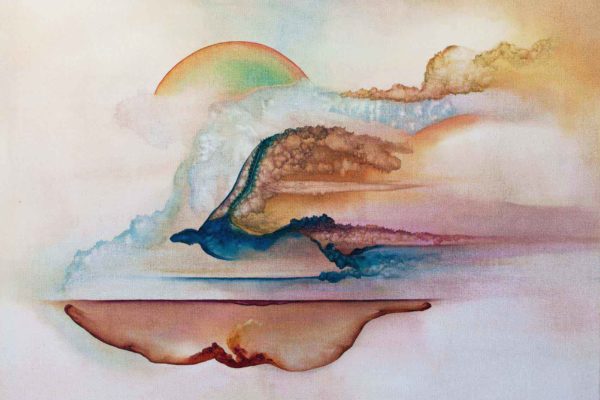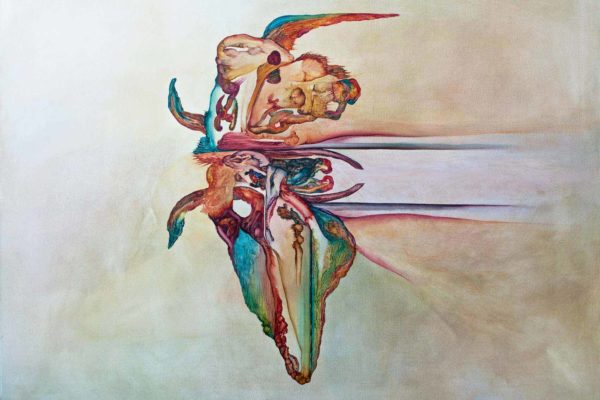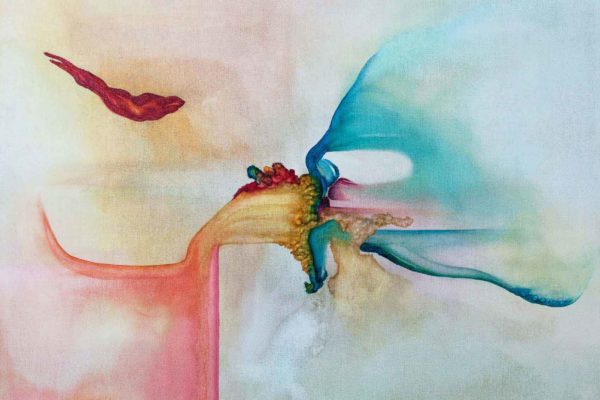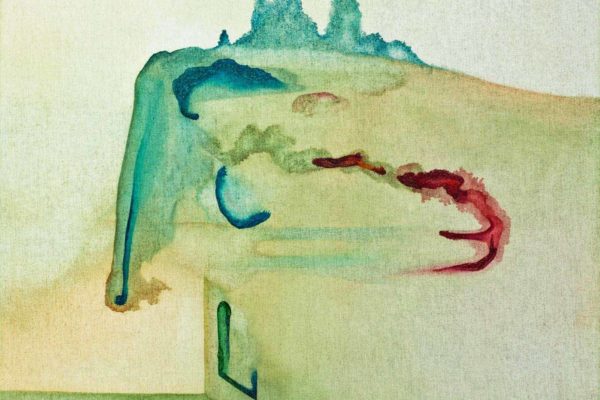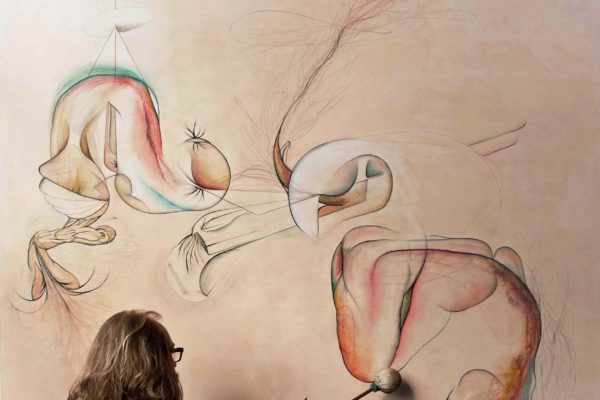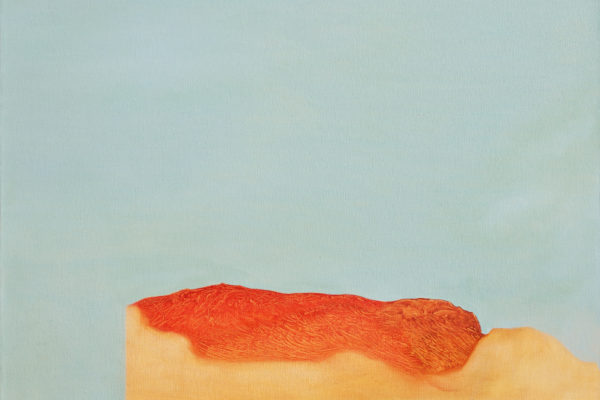The studio of Eduard Bigas is located on the top floor of an industrial brick cube in Berlin-Reinickendorf. As I visit the Catalan artist, who has now lived in Berlin for five years, for the first time on a dull January day, it seems to me that with each step I take up the solid staircase, I distance myself from the cold grey city through which I have rushed with hunched collar and shoulders.
Bigas routinely opens the massive door of his studio, greets the carpenter who works next door and ushers me into his atelier. “The studio is the only place where I am myself. It is the perfect place to escape,” he says sincerely. I step into the bright, roughly-bricked room and my gaze sweeps over the walls and shelves: here hang and lie Bigas’s work from the last two years, predominantly oil paintings and various large-format pencil and chalk drawings. Some works are still in progress, others must first dry before the next stroke, several wait for the protective varnish. As the milky winter sun shines cautiously through the window, and our breath and the steam of the coffee, which Bigas has prepared on a simple stove, create small clouds in the cold atelier air, my gaze is drawn to a mounted three-tier composition. I see luminous shades of colour and rhythm; schematic, sometimes tangible forms, which then again withdraw; balanced shades of colour that float and communicate with one another. I see light, lightness, rhythm, colour, balance. Bigas calls this great composition Sequences #Berlin, which is constructed from a series of individual square paintings. Monochrome surfaces, together with surreal, almost abstract landscapes and beings, some of which are surrounded by a black circular aperture, form a harmonious whole that, despite its size, exudes poetic ease. An ease that the artist also experienced through the artistic process: “It just happens, I cannot stop. The landscapes, they just popped up so easily. They came so easily.” My gaze wanders from landscape to landscape, from form to form, catches itself in delicate details and lets itself drift. In this expansive composition, Bigas not only places each individual painting in relation to the others, but situates the entire work in relation to the surrounding room. For in Sequences #Berlin, the artist has constructed a quite unique instalment for the current exhibition, The best of all possible worlds, at Galerie Kuchling, creating a temporary work that, in this form, can only be seen in the Karl-Marx-Allee. The strong appeal and almost meditative effect of the composition is based, on the one hand, on the perfect balance of colour and form which Bigas creates in such individual motifs as Ever and Ever or Spirit Garden, as well as in the overall composition. On the other hand, it is the stylistic representation of each individual motif that fascinates: whilst earlier works by the artist are clearly marked by a graphic, often black and seemingly unyielding line, Bigas disentangles himself from this firmly defined entity and dares to step into the medium of painting with a greater liberation of colour and form. With masterful ease, he balances on the line between fantastic and objective worlds, between the abstract and the figurative, between swimming, floating colours and fine, defining lines. A particularly bold connection between line and shape, limitation and space, is Bigas’s use of the circular aperture, which, like in early silent films, focuses our gaze by narrowing the image frame. In Sequences #Berlin, it becomes a repetitive motif, providing a rhythmic structural element to the whole composition, and gives the impression – like peering through a telescope – of looking into a distant world. But what kind of world is this, this world of Eduard Bigas? I look around his atelier and see a carefully arranged cosmos: brushes lined up, colour tubes side by side, various spatulas mounted with care on the walls. But for Bigas, his studio is more than just a well-organised workroom: it is both his place of retreat and his point of artistic departure, in which he can devote himself wholly to painting and drawing the world in his mind’s eye. And for this world, which can only be grasped at with such words as ‘imaginary world’ and ‘fantasy’, Bigas creates an artistic counterpart on the canvas, such as in Sequences #Berlin or the large Triptych Sequences, which show the same care and attention as is found in his studio. Each delicate line, every fine colour, every shimmering nuance is the product of an immensely sharpened eye, a masterful hand and a creative urge that pushes its way out. For the moment at which Bigas’s landscapes, shapes and beings assume colour and form on the canvas, they depart from the artist’s interior world and cross the border to the outside, becoming – as they do now at Galerie Kuchling – the mediator between the artist and the viewer. “It is a way of saying: ‘I am here’”, Bigas explains, and he shows me the large-format oil painting The best of all possible worlds, which lends its name to the exhibition. I see a barren landscape of delicate ochre and violet tones, over which a rainbow ascends to heaven and eventually sinks into a cloud. At the same time, a monstrous red organic form emerges from the cloud; Bigas calls it ‘Ego’. In The best of all possible worlds, this menacing force floats above everything, but does not diminish the luminosity of the rainbow, whose compositional counterpart it is. Rather, the Ego is an important part of the balance, which prevails in this best of all possible worlds. It is a fragile and perhaps questionable balance, however, which Leibniz establishes, optimistically and full of confidence in God and the world, in his postulate of the same name, and which Voltaire would go on to satirise in Candide. Indeed, it is the disparity between the ideal inner world and the real exterior world which made Voltaire a cynic. And Bigas, who is anything but a non-political dreamer, and who is aware of the current political developments in his homeland Europe, feels this gap, skips over it decisively and deliberately leaves the world behind with every brush stroke on the canvas. “It is the perfect excuse to escape…” It is therefore unsurprising that most of his current paintings, in contrast to our overcrowded world, are unpopulated – apart from the human body forms and somewhat erotic structures which Bigas outlines with oil, chalk and pencil in Continuous Present. Indeed, the exclusion of the human form and Bigas’s balancing between abstraction and objectivity provide him with a creative freedom, a free space that leaves room for different interpretations, thoughts and feelings, and never crushes the work of art – and the artist – with a final interpretation: “I want to keep it between reality and fantasy… I feel comfy there. There I can keep it private. Nobody is going to step there… I am aware what happens [in the world] but I don’t want to include that in my work… I want to keep it safe for myself.” With the same brush stroke with which Bigas says “I am here”, here also withdraws himself, and in this paradox, preserves the fragile and poetic state of uncertainty in his works.
And when, following our conversation, I step from the atelier into the cube, and from the cube into the world outside and stomp through the streets in the thick snowstorm, I still think: perhaps we live, regardless, or even in the face of, all (in)human impossibilities, in the best of all possible worlds. After all, it is a world in which artists like Eduard Bigas, with the aid of some colour on a canvas and an unshakeable creative urge, succeed in helping us forget about the harsh contrasts of our world for a moment, and instead recognise its bright colours, its incomprehensibly beautiful rhythm and its infinite variety of forms as essential details of a whole – if only for the period of a contemplative moment in a studio or exhibition.
Text: Claudia Heidebluth, Translation: William Russell
Interview with Eduard Bigas about the exhibition
Eduard Bigas was filmed by Diana Vishnevskaya and Igor Zwetkow, the music is created by Hoshiko Yamane.
On the occasion of the exhibition Galerie Kuchling publishes a catalogue about Eduard Bigas’s artwork.
ARTIST
